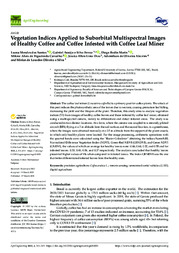Vegetation indices applied to suborbital multispectral images of healthy coffee and coffee infested with coffee leaf miner.
Vegetation indices applied to suborbital multispectral images of healthy coffee and coffee infested with coffee leaf miner.
Autoria: SANTOS, L. M. dos; FERRAZ, G. A. e S.; MARIN, D. B.; CARVALHO, M. A. de F.; DIAS, J. E. L.; ALECRIM, A. de O.; SILVA, M. de L. O. e
Resumo: The coffee leaf miner (Leucoptera coffeella) is a primary pest for coffee plants. The attack of this pest reduces the photosynthetic area of the leaves due to necrosis, causing premature leaf falling, decreasing the yield and the lifespan of the plant. Therefore, this study aims to analyze vegetation indices (VI) from images of healthy coffee leaves and those infested by coffee leaf miner, obtained using a multispectral camera, mainly to differentiate and detect infested areas. The study was conducted in two distinct locations: At a farm, where the camera was coupled to a remotely piloted aircraft (RPA) flying at a 3 m altitude from the soil surface; and the second location, in a greenhouse, where the images were obtained manually at a 0.5 m altitude from the support of the plant vessels, in which only healthy plants were located. For the image processing, arithmetic operations with the spectral bands were calculated using the ?Raster Calculator? obtaining the indices NormNIR, Normalized Difference Vegetation Index (NDVI), Green-Red NDVI (GRNDVI), and Green NDVI (GNDVI), the values of which on average for healthy leaves were: 0.66; 0.64; 0.32, and 0.55 and for infested leaves: 0.53; 0.41; 0.06, and 0.37 respectively. The analysis concluded that healthy leaves presented higher values of VIs when compared to infested leaves. The index GRNDVI was the one that better differentiated infested leaves from the healthy ones.
Ano de publicação: 2022
Tipo de publicação: Artigo de periódico
Unidade: Embrapa Café
Palavras-chave: Agricultura de Precisão, Agricultura digital, Coffea Arábica, Sensoriamento Remoto
Observações
1 - Por padrão são exibidas publicações dos últimos 20 anos. Para encontrar publicações mais antigas, configure o filtro ano de publicação, colocando o ano a partir do qual você deseja encontrar publicações. O filtro está na coluna da esquerda na busca acima.
2 - Para ler algumas publicações da Embrapa (apenas as que estão em formato ePub), é necessário ter, no celular ou computador, um desses softwares gratuitos. Sistemas Android: Google Play Livros; IOS: iBooks; Windows e Linux: software Calibre.
Acesse outras publicações
Acesse a Base de Dados da Pesquisa Agropecuária (BDPA) para consultar o acervo completo das bibliotecas da Embrapa.

